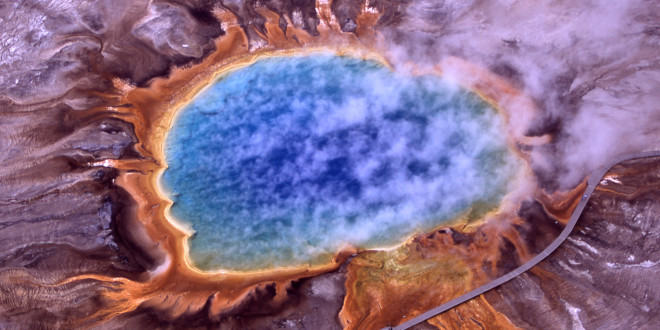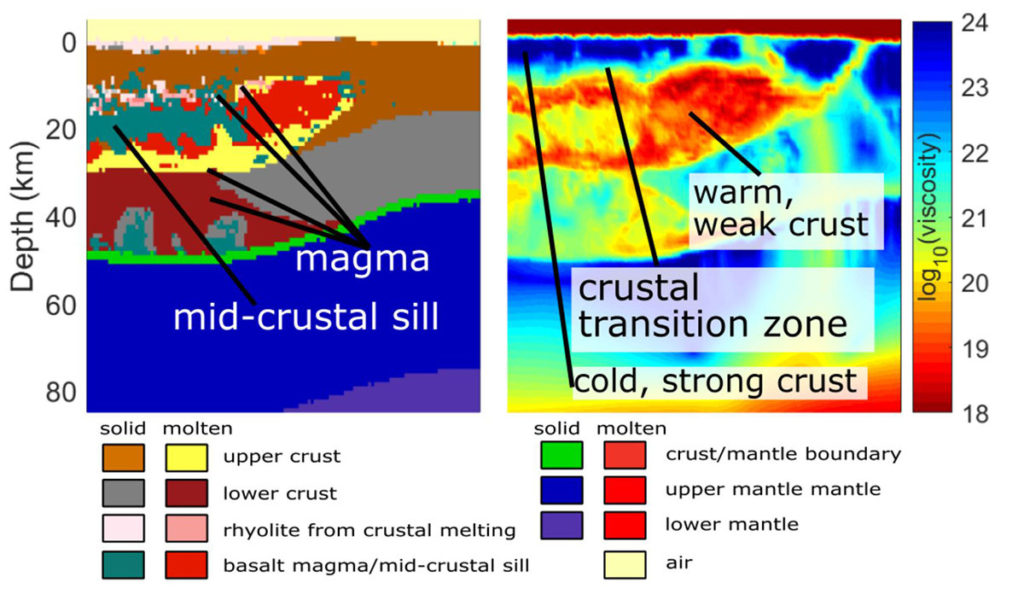Researchers at the University of Oregon are using a supercomputer to decipher the mystery of the Yellowstone caldera.
Among other things, the team is hoping to learn how to predict future eruptions.
According to a UO press release, the team (led by Earth Sciences doctoral student Dylan Colón) partnered with researchers at the Swiss Federal Institute of Technology (ETH Zurich) to write supercomputer codes specially designed for the Yellowstone caldera.
The team received grants from the National Science Foundation and support from the Jay M. McMurray Fund to conduct their work.
The team’s findings have been published in a study in Geophysical Research Letters.
The study focuses on a transition zone three to six miles (4.83 to 9.66 kilometers) below the surface of Yellowstone. Using supercomputer modeling, the team has produced images of the mineral/magma composition and temperature beneath Yellowstone. You can see an image of the modeling below, courtesy of UO.
According to Phys.org, the modeling done by Colón and his team accords with previous research done tracking seismic waves traveling beneath Yellowstone. Study co-author and UO Earth Sciences professor Illya Bindeman told Phys.org that their work “appears to validate initial assumptions and gives us more information about Yellowstone’s magma locations.”
According to the release, Colón et al.’s findings have broad applicability to supervolcanoes worldwide, but don’t say anything about the current state of Yellowstone’s eruption cycle:
The structure at Yellowstone, however, may explain past explosive eruptions, said UO geologist Ilya Bindeman, a study co-author.
“This is the nursery, a geological and petrological match with eruptive products,” he said. “Our modeling helps to identify the geologic structure of where the rhyolitic material is located.”
[…]
“This research helps to explain some of the chemical signatures that are seen in eruptive materials,” Colón said. “We can also use it to explore how hot the mantle plume is by comparing models of different plumes to the actual situation at Yellowstone that we understand from the geologic record.”
According to the study, pockets of rhyolitic magma are evident underneath Yellowstone. This type of magma is lower in temperature and more viscous than other magma. Nonetheless, it does not flow well, meaning that pressure can build up over time, which could lead to an eruption.
According to Phys.org, Colón’s will now look at how the chemical composition of different magmas affects volcanic eruptions.
It is worth stressing here that this study does not change the timeline on the Yellowstone caldera erupting—we are not “due” for an eruption.
Yellowstone National Park is a hotspot for geophysical research, which hones in on the region’s seismic/volcanic dynamics. Of especial interest is the source of Yellowstone’s heat, which is a point of contention among researchers.
Underneath Yellowstone are several large chambers of magma; one is filled with enough material to fill the Grand Canyon of Arizona over 14 times. The prevailing theory is that Yellowstone’s heat comes from this “plume” of magma just below the surface.
Researchers from the University of Texas at Austin published a paper this year summarizing plume theory and argued that magma could be coming to Yellowstone from as far away as Mexico.
Criticism of plume theory abounds, which began with the theory’s introduction in the early 1970s. Indeed, some geologists have called it a “zombie science.”
Looking at Yellowstone specifically, some researchers argue Yellowstone’s heat can’t come from a magma plume because of a tectonic slab currently sitting above the plume. Lijun Liu of the University of Illinois and his team have argued Yellowstone’s heat is funneled from the Pacific Coast.
 Yellowstone Insider Your Complete Guide to America's First National Park
Yellowstone Insider Your Complete Guide to America's First National Park







You must be logged in to post a comment.